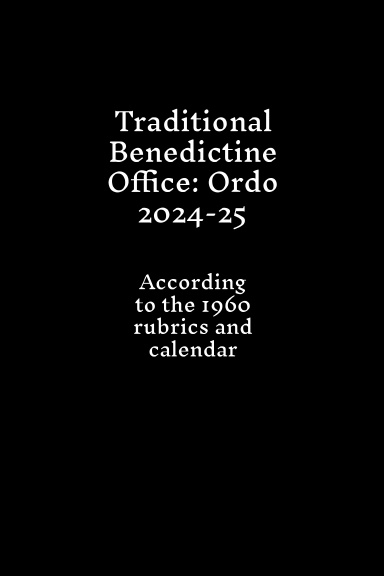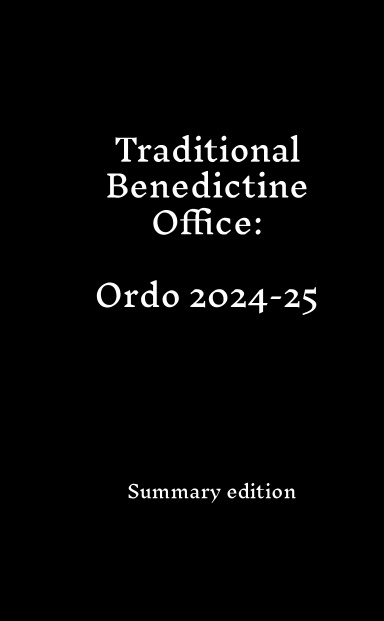 |
| Source: Gregobase/Dominique Crocu |
Today is the feast of the conversion of St Paul, and it is part of a strong Pauline focus in the Office in January, as the Pauline Epistles are read at Matins each day in this period.
In honour of this, I want to provide a brief note today, by way of the first of a series of posts on the 'de psalmiis' Matins responsories, partly in response to two recent blog posts on this topic.
The Matins responsories
The Matins responsories are a huge, rich repertoire of chants (by the end of the middle ages there were more than 1500 of them, and there are also quite a few polyphonic settings of them), traditionally sung after each of the readings in the Night Office (and occasionally at Vespers). The responsories provide both a space to meditate on the readings (or feast or season); and act as something of an aid to interpreting and assimilating them.
In the centuries since Trent, though, a few special times of the year aside, they have generally been said rather than sung, and their texts and chants have been of more interest to liturgists than to those interested in the ways text and music interact to provide theological and spiritual content.
That is slowly changing though, and projects are currently underway, both to build on the pioneering work of Peter Sandhofe's 2002 Nocturnale Romanum, through the Nocturnale Romanum Project, and the work of the Monastery of Brignoles to develop an equivalent set of books for the monastic Office.
The history and spirituality of the responsories
Despite this, however, the primary focus on them, not least in the latest two posts on the subject, continues to be as indirect evidence for assorted historical claims regarding the development of the Office.
The first post, on the Esprit de la Liturgie website, is by Matthias von Pikkendorff, entitled Les répons psalmiques du temps après l’Épiphanie. It includes some useful notes on the chant of the first of the set, Domine ne in ira tua, but its prime focus is on the responsories as evidence for the claimed shape of the early Roman Office.
The second post, by Gregory diPippo on the New Liturgical Movement Blog has a similar thrust, focusing on three of the set included in the monastic, but not the post-Trent Roman Office.
The de psalmiis responsories and the early Roman Office
In essence, both build on and/or repeat past claims that it is 'self-evident' that the psalm based responsories used in the weeks after the Epiphany represent a proto-responsory set in place by the late fifth century, but gradually displaced by the 'historia' sets based on other books of the Bible, and preserved in their current order out of respect to their antiquity.
I will come back, in this series, to the reasons for rejecting this hypothesis but it is worth noting upfront I think, that there is virtually no evidence to even suggest that there actually was such a thing as Roman secular Matins (or that there was a single monastic office universally used) in Rome prior to St Benedict's time. Matins, after all, was predominantly a monastic domain, and seems only to have been imposed on the Roman clergy, at least as a daily obligation, in the mid-sixth century, after St Benedict's time.
The 'monastic responsories'?
Mr diPippo's post effectively supplements that of Mr von Pikkendorff by attempting to explain the reasons for the inclusion of a responsory in the Sunday set that clearly fits the monastic rather than the Roman ordering of Matins, as well as one that is not Scripturally based at all. In particular it proposes that three responsories were added to the Benedictine Office to make up the necessary number of responsories (since the Roman Office used only nine responsories on Sundays whereas the Benedictine has twelve) when the Benedictines adopted the Roman Office's reading and responsory cycle.
There are, however, several problems with this theory.
First, the three responsories in question appear just as often (indeed slightly more frequently) in medieval manuscripts based around the secular 'cathedral' cursus as they do in monastic ones.
Secondly, these are only three of many variant sets of responsories used in the Office prior to the post-Trent breviaries. Indeed the 'Old Roman' manuscripts contain several not used in the modern Office, while the key monastic Hartker manuscript contains no less than 14 for Sunday, and six to choose from for Monday.
Thirdly, musicological analysis of one of the chants cited by Mr diPippo, Peccata mea has found that it shares the musical features of the other 'core' responsories of the set.
An alternative theory
In the light of all this, I want to put forward an alternative, in my view more plausible explanation for this set of responsories, namely that while the responsories themselves may be relatively ancient, perhaps dating from the fifth century, the selection and ordering of them found in the surviving antiphoners from the ninth century onwards is not, but rather reflects a reform of the Matins reading cycle that occurred in the eighth century.
Originally, it should be noted, there was a much stronger Pauline focus in the monastic office (and almost certainly in the early Roman one as well). Although the pre 1962 Roman Office (and 1960 Benedictine Office) uses homilies based on the Gospel of the day in the Third Nocturn of Matins on Sundays, St Benedict actually prescribed readings from the New Testament for this Nocturn.
And two of the earliest of the 'ordines Romani' (Ordos XIV and XVI), dating from the seventh century but almost certainly reflecting earlier practice, are consistent with this, saying that the Pauline Epistles were read throughout the year.
Moreover the second of these Ordines explicitly says that the de psalmiis responsories were also used throughout the year.
Could it be that they were actually used specifically in conjunction with the Pauline epistles? There are good reasons for thinking so.
One of those reasons is that one of the versions of the oldest record of the Matins reading cycle we are familiar with, dating from the eighth century, actually specifies that St Augustine's Enarrations on the psalms were to be read in conjunction with the Epistles.
Now it might be thought that St Augustine's commentaries on the psalms were an obvious choice if the reason for the use of the psalm-based responsories was to reflect their dual character in the early Office as both readings and prayers. But there is, I think another reason for this choice as well, in the heavy Pauline content of this set of commentaries.
St Augustine's Enarrations and the Pauline epistles
Although St Augustine's Enerrations are based around particular psalm numbers, they were evidently given on occasions when the Epistles were also read, as St Augustine frequently makes reference to this.
And independently of this, his explanations are rich in references to 'the Apostle'.
When he explains the meaning of the psalms, quotations from the Epistles often far outnumber St Augustine's citations from other New or Old Testament books.
He also frequently uses incidents from St Paul's life to explain the meanings of the psalms.
And it turns out that these references to the life and works of St Paul are disproportionately concentrated in the commentaries on the particular psalms used in this responsory set.
The Peccata mea responsory and the conversion of St Paul
And as it happens, one of the responsories highlighted by Mr diPippo is something of a case in point.
Here is the text of the responsory as it appears in the current Benedictine Office for reference purposes:
R. Peccáta / mea Dómine sicut sagíttae infíxa sunt in me, † sed ántequam vúlnera génerent in me * Sana me Dómine medicaménto poeniténtiae, Deus. V. Quóniam iniquitátem meam cognósco, † et delíctum meum contra me est semper, qui tibi soli peccávi. R. Sana me Dómine medicaménto poeniténtiae, Deus. | R. My sins, O Lord, are fixed in me, like arrows, but before they caused wounds in me, * Heal me, O God, with the medicine of repentance. V. For I know my iniquity, * and my sin is always before me. R. Heal me, O God, with the medicine of repentance. |
The first point to note is that the the 'respond' section is mostly adapted from various verses of Psalm 37, the third penitential psalm (the whole set of Epiphanytide responsories has a strong penitential flavour, something I plan to come back to). This kind of adaptation process is very common in responsories, including in this set.
The 'verse' (from Psalm 50) is actually not from the Gallican or Romanum, but the Vetus psalter, which might normally be taken as indicating either antiquity, rather than it being a late composition, or perhaps a non-Roman or Gallic origin (there are several distinct 'dialects' of responsories that have been identified, including Beneventan, Ambrosian, Old Hipanic and Gallican).
In this case, though, I'd suggest that it has probably been taken straight from St Augustine's commentaries on the psalm, since the particular verses of Psalm 37 used in the respond very much echo the emphasis of St Augustine's commentary on both that psalm, as well as that on Psalm 50.
Both, moreover, contain explicit references to St Paul's conversion on the road to Damascus. On Psalm 37, for example, he says:
Why should He not say, from the face of my sins, who said to Saul, Saul, Saul, why do you persecute Me, who, however, being in Heaven, now suffered from no persecutors?
And on Psalm 50 he makes a major play on the identity between the names of David's persecutor (King Saul), and St Paul's name before his conversion, working up to a quote from the reading used for today's feast, Acts 9. His commentary also links neatly to the second half of the respond text, with its references to the healing medicine of repentance:
...You shall be sprinkled with hyssop, the humility of Christ shall cleanse you. Despise not the herb, attend to the efficacy of the medicine. Something further I will say, which we are wont to hear from physicians, or to experience in sick persons. Hyssop, they say, is proper for purging the lungs. In the lung is wont to be noted pride: for there is inflation, there breathing. It was said of Saul the persecutor as of Saul the proud, that he was going to bind Christians, breathing slaughter: (Acts 9:1) he was breathing out slaughter, breathing out blood, his lung not yet cleansed. Hear also in this place one humbled, because with hyssop purged: You shall wash me, that is, shall cleanse me: and above snow I shall be whitened. Although, he says, your sins shall have been like scarlet, like snow I will whiten. Out of such men Christ does present to Himself a vesture without spot and wrinkle. Further, His vesture on the mount, which shone forth like whitened snow, signified the Church cleansed from every spot of sin.
You can find three polyphonic settings of this responsory in Mr diPippo's post over at NLM, and you can find the next part in this series here.








